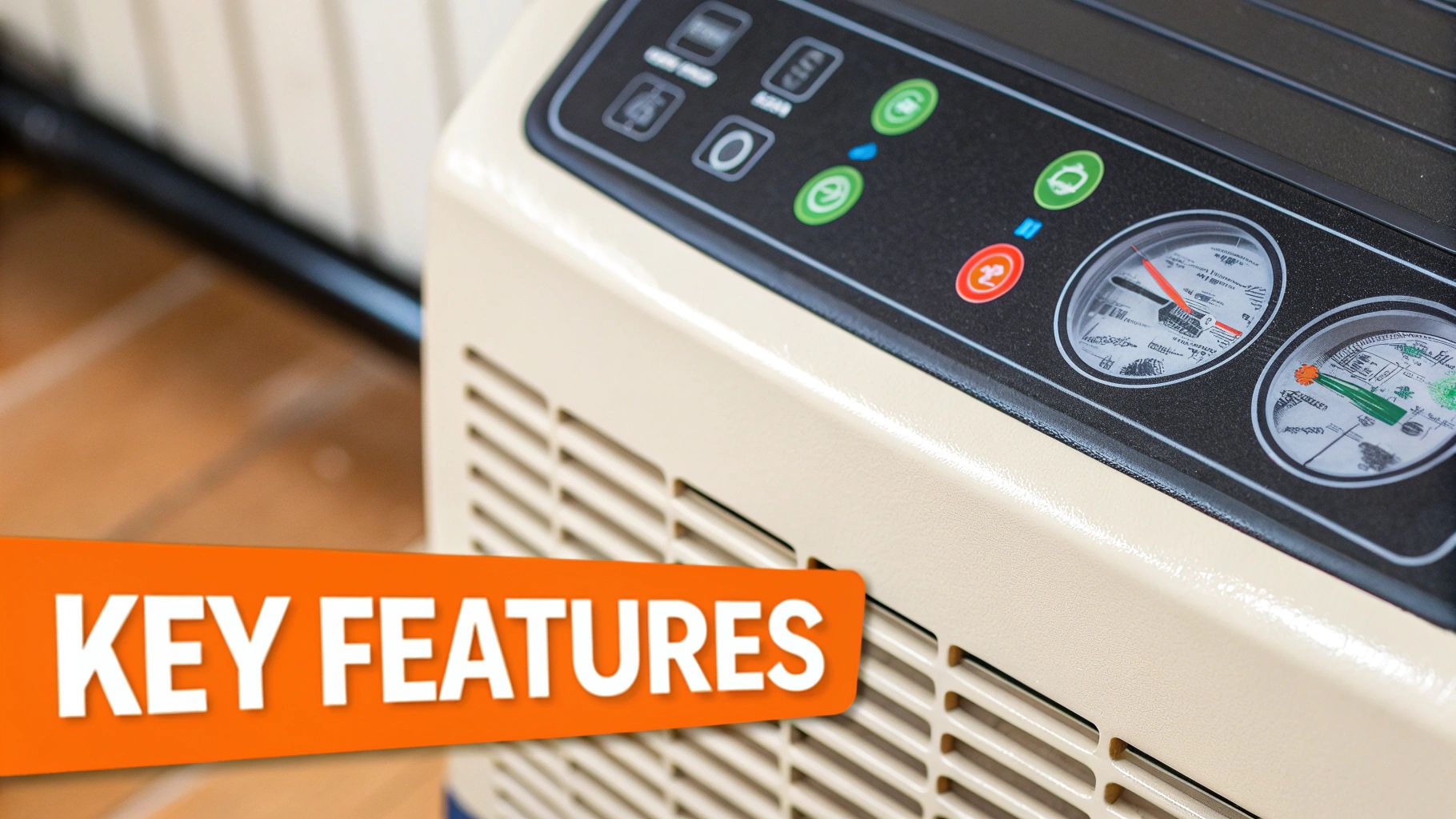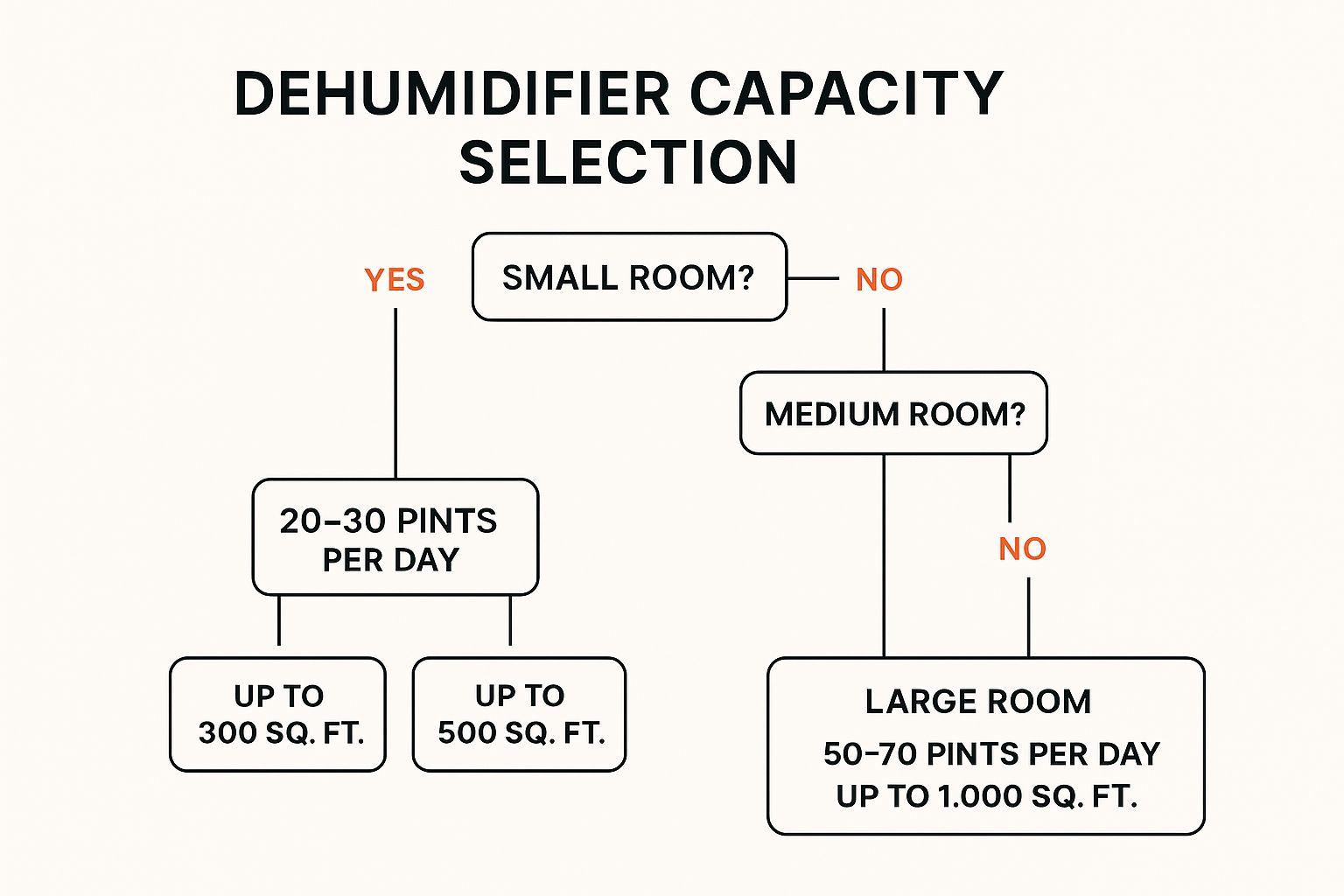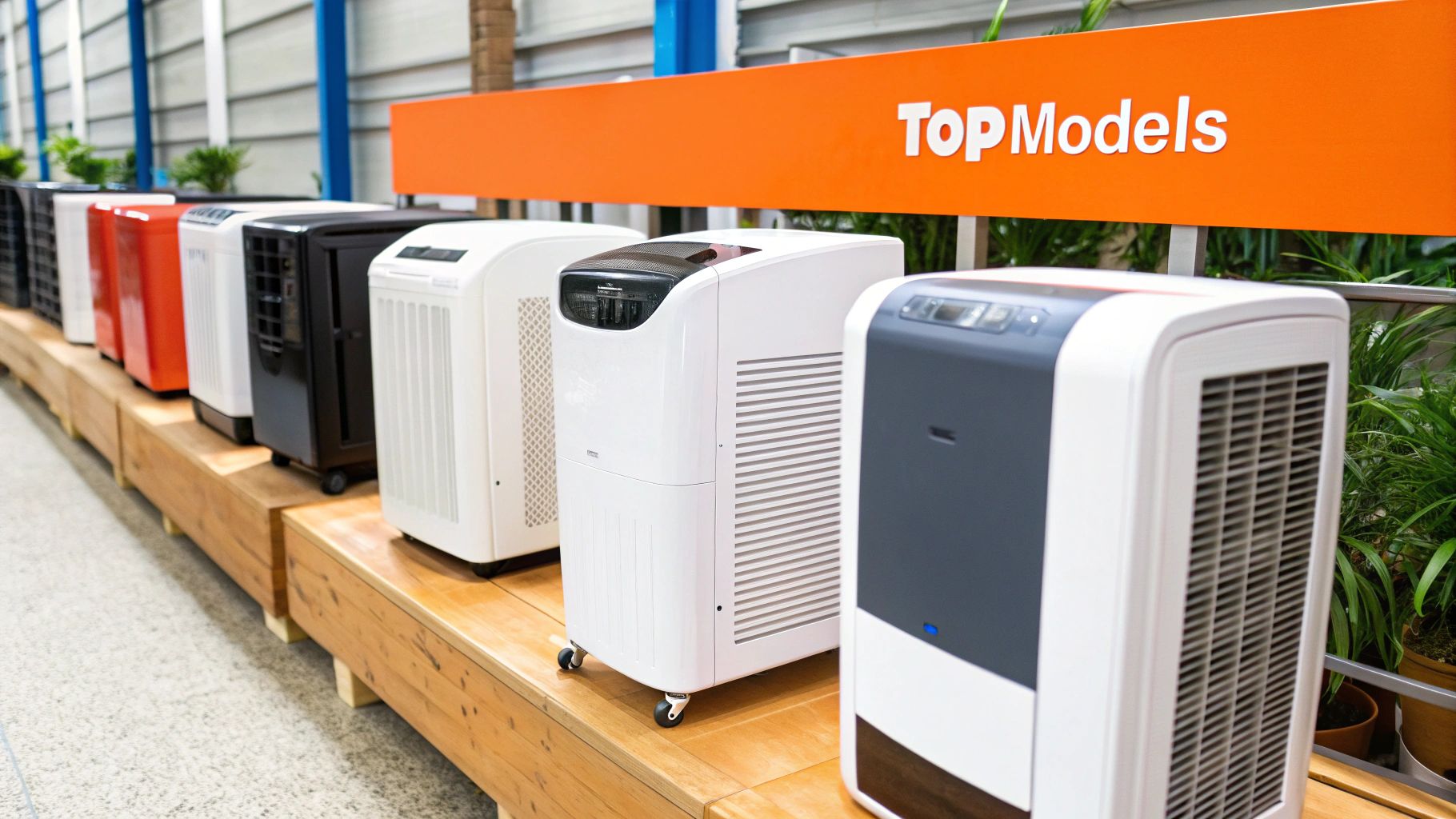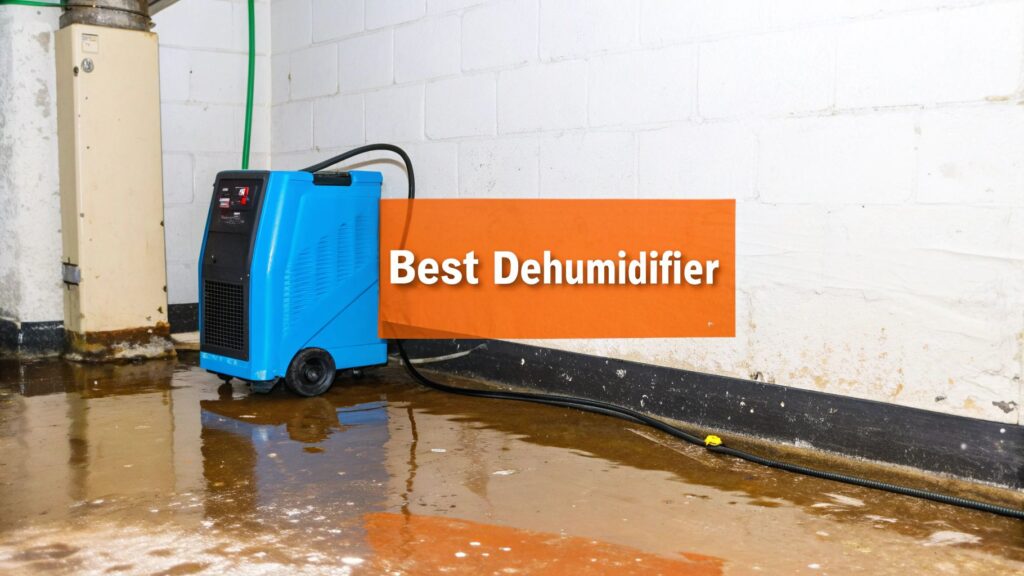When your property is impacted by water damage, the best dehumidifier is always a professional-grade unit. Specifically, you need a Low-Grain Refrigerant (LGR) dehumidifier. These are not the small plastic units available at a big-box store; they are powerful, industrial machines engineered to aggressively extract extreme amounts of moisture from soaked materials like drywall, subfloors, and wood framing. As an IICRC Master Certified restoration firm, we know this is the only reliable way to stop mold growth and prevent long-term structural problems after a leak or flood.
Why Your Choice of Dehumidifier Is Crucial After Water Damage
When your Orange County property suffers water damage, the clock starts ticking—fast. The standing water you see is merely the surface problem. The real danger is the hidden moisture that wicks deep into porous building materials, creating the perfect breeding ground for mold, which can begin to grow in as little as 24-48 hours.

Imagine trying to dry a completely saturated kitchen sponge. You can wipe the surface, but the core remains soaking wet. If you simply place a small desk fan next to it, the sponge will stay damp for days. That’s what using a standard residential dehumidifier after a serious water event is like—it lacks the power to pull moisture from deep within saturated structures.
Now, picture aiming a high-velocity blower and a heat source at that same sponge. The combination of intense airflow and energy would extract every drop of water in a fraction of the time. That’s what a professional LGR dehumidifier does for your home. It creates an intensely dry atmosphere that literally forces moisture out of your home’s structure, stopping the damage cold.
Residential vs. Professional Dehumidifiers At a Glance
It’s easy to assume any dehumidifier will do the job, but the difference between consumer-grade units and professional equipment is night and day. Here’s a quick breakdown of what sets them apart.
| Feature | Residential Dehumidifier | Professional (LGR) Dehumidifier |
|---|---|---|
| Extraction Rate | Low (20-50 pints/day) | Very High (80-200+ pints/day) |
| Operating Range | Limited, works best in mild conditions (65-80°F) | Wide, effective even in cool, damp environments |
| Durability | Plastic housing, designed for light home use | Rugged, commercial-grade construction for job sites |
| Airflow (CFM) | Low (around 150 CFM) | High (250-400+ CFM) to cover large areas |
| Focus | Maintaining general comfort | Aggressive structural drying and moisture removal |
| Cost | $200 – $400 | $2,000 – $5,000+ |
As you can see, a residential unit is built for comfort, not for crisis. For true water damage mitigation, there is simply no substitute for professional-grade power and performance.
The Dangers of Inadequate Drying
Gambling with the wrong equipment can lead to devastating consequences that are far more expensive and stressful than the initial water damage. Without rapid and thorough drying, you face serious risks:
- Destructive Mold Growth: Mold thrives in damp, dark spaces. Once it takes hold, you’re facing potential health hazards and costly, specialized remediation.
- Structural Rot: Lingering moisture will cause wood framing, subfloors, and drywall to weaken, decay, and potentially fail over time.
- Warped Materials: Hardwood floors, kitchen cabinets, and interior doors can swell, buckle, and become permanently ruined.
- Lingering Odors: The musty, damp smell from hidden mold and moisture can permeate your home or business and is nearly impossible to eliminate without proper drying.
At Sparkle Restoration Services, our IICRC Master Certified technicians know that real water damage mitigation isn’t just about mopping up water—it’s about controlling humidity with scientific precision. As a BBB Torch Award Winner for ethics, we use only professional-grade LGR dehumidifiers and advanced moisture-monitoring tools to guarantee your property is brought back to a safe, dry, pre-loss condition, turning chaos into calm.
Knowing how to detect water leaks early is your first line of defense, but once damage has occurred, the right technology is non-negotiable. As we explain in our guide to understanding the complexities of water damage, the science behind structural drying is exact and requires professional tools for a successful outcome. The difference between a consumer gadget and professional equipment is often the difference between a minor inconvenience and a major financial disaster.
How Professional Dehumidifiers Win the Fight Against Water Damage
To truly understand why professional equipment is essential for water damage, we need to look at the science of structural drying. It’s all about physics. Moisture naturally moves from areas of high concentration to areas of low concentration, much like air rushing out of a balloon. The high pressure inside wants to equalize with the lower pressure outside.

After a flood in an Orange County home, your soaked drywall, wood studs, and floors are that high-pressure balloon. The air around them is the low-pressure zone. A professional dehumidifier’s job is to make the air in the room so incredibly dry that it practically rips the moisture right out of those materials.
The Science of Dry Air, Explained
Restoration professionals use precise measurements to assess moisture levels and track drying progress. You don’t need to be a scientist, but understanding two key terms will demonstrate how we achieve such powerful results. These concepts are at the heart of our IICRC-certified approach.
- Relative Humidity (RH): You’ve likely heard of this. It’s a percentage that shows how much moisture is in the air compared to the maximum it could hold at a specific temperature. While useful, it can be deceiving because warm air holds significantly more water than cold air.
- Grains Per Pound (GPP): This is the metric that truly matters to a restoration professional. GPP measures the absolute weight of water vapor in a pound of air. It’s a direct, unambiguous measurement that allows us to create the driest environment possible, regardless of temperature.
A store-bought dehumidifier might lower the RH slightly, but it lacks the power to drop the GPP to the levels required for aggressive drying. The best dehumidifier for water damage is one that can drive the GPP down to near-zero levels, turning the air itself into a powerful “moisture magnet.”
Our goal at Sparkle Restoration Services is to create a “drying vortex” on your property. By using advanced equipment to drop the GPP into the single digits, we create an environment so dry that moisture has no choice but to leave saturated materials and enter the air, where our machines capture and remove it for good.
Two Professional Technologies for Every Scenario
In professional water damage restoration, we rely on two main types of dehumidifiers. Each has unique strengths, and knowing which one to deploy is the mark of an experienced, IICRC-certified team like Sparkle. Selecting the right tool ensures drying is faster and more efficient, saving you time and preventing secondary damage like mold. For a deeper dive, check out our article on the fundamentals of water damage and drying.
Low-Grain Refrigerant (LGR) Dehumidifiers
LGR units are the undisputed workhorses of our industry, especially in the mild Southern California climate. They function much like a high-powered air conditioner by pulling in moist air and cooling it over refrigerated coils. This forces the water vapor to condense into liquid, which is then pumped out and away.
What makes an LGR exceptional is its “pre-cooling” system. This feature allows the machine to achieve much lower humidity levels (and therefore lower GPP) than a standard dehumidifier. They are incredibly powerful and efficient for most home and business floods in Orange County.
Desiccant Dehumidifiers
Desiccant dehumidifiers operate on a different principle. Instead of using cold coils, they pass moist air through a special material that absorbs water—think of a high-tech silica gel wheel. Moisture is chemically pulled from the air, and then a separate stream of hot air “bakes” the moisture out of the desiccant material, venting it outside the property.
The primary advantage of a desiccant is its incredible effectiveness in cold temperatures, where LGRs begin to struggle. When we’re drying unheated spaces, walk-in coolers, or handling specialized industrial projects in Irvine or Newport Beach, a desiccant is often the only tool for the job. Understanding this distinction is key to implementing the right drying strategy and restoring your property with scientific precision.
Decoding the Specs That Truly Matter for Water Damage
When evaluating professional dehumidifiers, the technical specifications can be overwhelming. Manufacturers often highlight impressive-sounding numbers that don’t tell the whole story. To identify the best dehumidifier for water damage, one must look past the marketing and focus on the metrics that actually impact drying performance. As IICRC-certified professionals, we rely on specific data points to ensure we use the right tool for every project on your Orange County property.
Understanding these key specs helps you appreciate the real science behind an effective restoration. It’s what separates placing a machine in a room from strategically engineering a dry, safe environment.
Water Removal Capacity: Pints Per Day
The most common metric you’ll see is water removal capacity, measured in Pints Per Day (PPD). However, this metric can be misleading if you don’t know which rating system is being used. It’s critical to understand the difference between the two main standards.
- AHAM Rating: This is the gold standard in our industry. The Association of Home Appliance Manufacturers (AHAM) tests machines in realistic conditions: 60% humidity and 80°F. This rating provides a dependable, real-world benchmark for a dehumidifier’s performance in a typical drying situation.
- Saturation Rating: This number is derived from testing at 90% humidity and 90°F. While it produces a much higher PPD number that looks great on marketing materials, these swamp-like conditions are rarely encountered on a real water damage project. A unit might boast a 150 PPD rating at saturation but only pull 75 PPD at AHAM—that’s a 50% difference in actual performance.
When evaluating a dehumidifier, always prioritize the AHAM rating. It’s the only number that offers a trustworthy baseline for comparing the true power of different machines. If a contractor can’t tell you the AHAM rating, they may not possess the expertise your project requires.
This decision tree is an excellent visual for how factors like room size and moisture level guide the selection of the right dehumidifier.

As the graphic illustrates, larger spaces with more severe water damage demand units with a much higher PPD capacity to ensure efficient drying.
Airflow: Cubic Feet Per Minute
A dehumidifier’s water-pulling power is only half the battle. If it can’t process enough air, its extraction capacity is irrelevant. That’s where Airflow, measured in Cubic Feet per Minute (CFM), becomes crucial.
Think of CFM as the machine’s “reach.” A unit with a high CFM rating can circulate all the air in a large room multiple times an hour, ensuring every pocket of damp air is pulled over its cooling coils. A low-CFM unit, in contrast, might only dry the air immediately around it, leaving distant corners damp and ripe for mold growth.
For effective structural drying, we look for units with a CFM rating of at least 250-400 CFM. This powerful airflow, combined with strategically placed air movers, creates a drying vortex that eliminates stagnant, moist air and supercharges evaporation from wet materials.
Operating Temperature Range
Water damage doesn’t only happen on warm, sunny days. A pipe can burst in a cool Newport Beach basement, or a sprinkler can activate in a chilly Irvine commercial space during winter. This is why the operating temperature range is a non-negotiable specification for any professional-grade dehumidifier.
Standard residential dehumidifiers often stop working below 65°F as their coils freeze. Professional LGR (Low-Grain Refrigerant) dehumidifiers, however, are built to perform in a much wider range, often down to 33°F. This is a game-changing advantage.
In a 55°F crawlspace, a conventional dehumidifier would be virtually useless. An LGR unit, however, will continue to pull massive amounts of moisture from the air and materials, preventing the secondary damage that would otherwise occur. This capability means that no matter the conditions, we can begin aggressive drying immediately—a core part of our promise to turn “Chaos Into Calm, Fast.”
How Professionals Deploy Dehumidifiers for Maximum Effect
Owning the best equipment is one thing; knowing how to deploy it with scientific precision is what truly separates professional restoration from guesswork. At Sparkle Restoration Services, our IICRC-certified technicians follow a strategic playbook on every water damage job in Orange County. This methodology ensures we dry your property not just quickly, but completely.
Simply placing a dehumidifier in a wet room is like trying to drain a swimming pool with a bucket—it won’t work efficiently. Real structural drying is an engineered process focused on creating a contained, controlled environment where we let physics do the heavy lifting at maximum speed.
This methodical approach is the core of our promise to turn “Chaos Into Calm, Fast.” It’s a combination of elite technology and the deep expertise that comes only from years of in-the-field experience.
Calculating the Right Drying Power
The first step is always assessment, never a guess. Before any equipment is plugged in, our technicians perform a thorough evaluation to calculate the exact amount of dehumidification power needed. This goes beyond just room size. We use a formula that considers the class of water damage, the specific materials affected (drywall, hardwood, and concrete all behave differently), and initial moisture readings.
Using an industry-standard formula, we determine the required Pints Per Day (PPD) of water removal. This calculation tells us precisely how many LGR dehumidifiers to use and of what capacity, creating ideal drying conditions without wasting time or energy. Underpowering a job is a recipe for disaster, as it allows moisture to linger and creates a perfect breeding ground for mold.
Creating a Contained Drying Chamber
To maximize our equipment’s efficiency, we must control the environment. Our technicians create a contained drying chamber by sealing off the affected area from the rest of the property. This involves closing doors and windows and often using plastic sheeting to completely isolate the space.
Imagine trying to heat your home in winter with all the windows open. By containing the space, we ensure our powerful dehumidifiers are only working on the wet area, not trying to dry the entire building or humid outside air. This concentrates their drying power, which dramatically lowers the humidity (GPP) and accelerates the entire job.
The Drying Vortex: Placement and Air Movement
This is where true expertise shines. Equipment placement is a science designed to create a powerful drying vortex—a continuous, circular airflow that reaches every square inch of the affected area.
Our process creates a strategic partnership between two key pieces of equipment:
- LGR Dehumidifiers: We position these units centrally to draw in moist air from all directions. As the dehumidifier expels warm, intensely dry air, it lays the foundation for the vortex.
- Axial Air Movers: These are not average fans. We place high-velocity air movers around the room’s perimeter, angling them at 45 degrees toward the walls. This focused airflow blasts across wet surfaces, shearing moisture molecules off materials and pushing them into the air.
This combination creates a powerful, circular airflow. The air movers lift moisture into the air, and the dehumidifier captures it, wrings it out, and sends dry air back into the system. It’s a highly effective method that ensures no stagnant, humid pockets can hide in corners or behind cabinets. Professionals know that the best dehumidifier for water damage is even more effective as part of a complete system, leveraging general heating and air management principles to perfect the drying conditions.
Our technicians don’t just set equipment and walk away. We use advanced tools like thermal imaging cameras and non-invasive moisture meters to hunt for hidden water pockets. We then adjust equipment placement to target these problem areas, ensuring no moisture is left behind.
Continuous Monitoring and Scientific Validation
Finally, a professional job is never a “set it and forget it” operation. Our IICRC-certified technicians return daily to monitor progress with advanced moisture meters. We take readings from affected materials and the air, tracking the drop in moisture content against scientifically established drying goals.
We document this data meticulously, providing you with proof that your property has been returned to its proper, pre-loss dry standard. This data-driven validation is your assurance that the job is done right, preventing the long-term risks of hidden dampness. In fact, inadequate drying is a primary reason property owners face recurring issues; you can learn more about the consequences by reading the common facts and myths about mold and mold remediation.
Common Questions About Dehumidifiers and Water Damage
When you’re dealing with the aftermath of a water event, having a flood of questions is completely normal. As Orange County’s premier restoration experts, our job is to provide clear, straightforward answers. We want to reduce your stress and help you feel confident about the recovery process. This is where we explain why professional-grade equipment isn’t just a suggestion—it’s a necessity.

Here are a few of the most common questions our IICRC-certified technicians hear from homeowners and property managers.
Can I Just Use My Home Dehumidifier After a Leak?
While your residential dehumidifier is perfect for keeping a basement comfortable, it is completely outmatched by active water damage. A home unit simply lacks the power to pull moisture from deep within saturated materials like drywall, subfloors, and wood framing.
Relying on an underpowered machine provides a false sense of security while the clock is ticking. Drying will be painfully slow, and that delay is dangerous. Mold can begin to grow and colonize in as little as 24 to 48 hours. For anything more than a small surface spill, professional equipment is the only way to truly protect your property and health.
Think of it this way: a garden hose is great for watering plants, but you’d need a fire hose to extinguish a house fire. The scale of the problem demands a tool with proportional power. The best dehumidifier for water damage is always a professional one.
How Long Will the Dehumidifiers Need to Run?
There is no single answer—the total drying time depends on the extent of the damage, the materials affected, and the property’s conditions. That said, a typical professional drying project usually runs for about three to five days.
However, we never guess. The Sparkle Restoration Services team doesn’t just drop off equipment and hope for the best. Our certified technicians use calibrated moisture meters to take daily readings of all affected materials. We track the progress scientifically until every part of your property returns to its established, pre-loss dry standard. This data-driven approach ensures we dry everything completely without running the equipment a minute longer than necessary.
Will Running This Equipment Drive Up My Electricity Bill?
Yes, professional restoration equipment consumes a significant amount of power, so you will notice a temporary spike in your utility bill. However, it’s crucial to put this cost into perspective.
Modern LGR dehumidifiers are engineered for maximum efficiency, pulling the most pints of water per kilowatt of energy. The cost of running this equipment for a few days is minimal compared to the tens of thousands of dollars you could face for major mold remediation or structural repairs if the drying is done too slowly or incompletely.
Furthermore, this temporary utility cost is almost always considered a direct expense of the water damage event. This means it’s a coverable part of your property insurance claim, and our team will help you document everything for your adjuster.
Why Do You Use Big Fans Along With the Dehumidifiers?
Those high-velocity fans, which we call air movers, are the essential partners to our dehumidifiers. They work together to create an incredibly powerful and efficient drying system. By itself, a dehumidifier can only remove moisture that is already in the air.
We strategically aim air movers directly at wet surfaces like floors, walls, and cabinets. This focused, powerful airflow dramatically speeds up evaporation—it literally lifts water off the materials and turns it into water vapor. Once airborne, the dehumidifier can easily grab that moisture-laden air, wring it out, and send warm, dry air back into the room to continue the cycle.
This tag-team approach creates a highly effective drying vortex that a dehumidifier alone could never achieve. For more answers to your restoration questions, please explore our frequently asked questions section.

